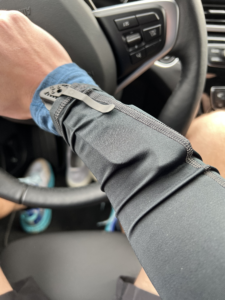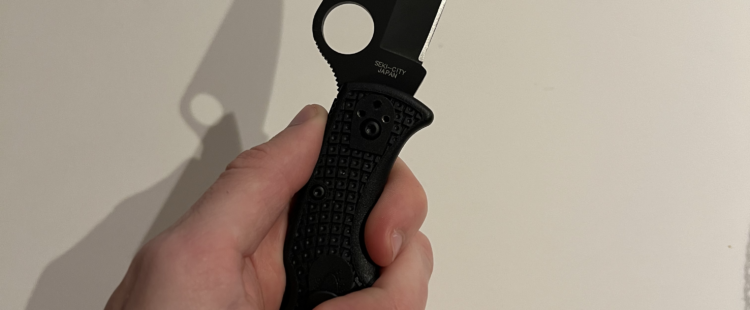Disclosure: I may earn affiliate revenue or commissions if you purchase products from links on my website. The prospect of compensation does not influence what I write about or how my posts are structured. The vast majority of articles on my website do not contain any affiliate links.
Everyone runs faster with a knife, right?
I’ve run thousands of miles and have never felt truly endangered by another living being. I’ve also never found myself in a survival situation such as getting stranded in a snowstorm or lost in the woods. Over the last few years, though, most of my mileage has been run in places that consensus would rank as not extraordinarily safe. This includes the densest parts of Chicago (high crime rates) and some far-flung remote routes such as the Grand Portage trail (high bear encounter rates). Sometimes I can’t help but stop and think… what if?
What if I found myself face to face with a wild animal in the woods?
How violated would I feel if my legs got torn up as I ran away from a dangerous dog?
If someone (likely a group of people) were intent on hurting me and sprinting away wasn’t an option, what would I do?
To take a page out of the Nasim Taleb playbook, many people drastically overpay for insurance policies that they don’t really need for risks that are extremely unlikely to occur. Does the benefit of carrying a folding knife while running or hiking (but especially running) outweigh the upfront premium of purchasing the knife and the continuous burden of carrying it with you? While many serious runners seem to regard this idea as lunacy, I think there’s some merit to it. Purchasing items for self-defense is taking out an insurance policy on affronts to your wellbeing.
I find it bizarre that companies now pedal all types of useless gear to average runners, but Runners World probably didn’t run a single article on self-defense products for runners until they saw the opportunity to collect affiliate revenue online.
Why Not Pepper Spray or a Stun Gun?
This is a valid question. Frankly, I’m not running around looking for trouble trying to test all different methods of self-defense. I can appreciate that having to use any method to escape danger (including your legs!) will be etched into one’s memory forever. It’s traumatic. You don’t forget that feeling of dread, even if you end up being perfectly safe.
Pepper spray is cheaper and more effective from a distance than a knife though often heavier with more awkward form factors. Stun guns, though used at a close range unless we’re talking about a taser that fires prongs, are also surprisingly cheap. There is also a lower chance that an adversary will be able to effectively use one of these items against you.
When we think about running in more remote places in more varied conditions, pepper spray doesn’t actually work that well in windy conditions, in the rain, or when it’s really cold. Also, when it comes to the wild animals in North America that will kill you (large cats, packs of canines, and bears), some pepper spray will further anger the animal and stun guns will be harder to use effectively.
Neither of these products will be anywhere near as useful as a tool like a knife if you’re stuck in the woods. Additionally, certain cities and states (like Chicago) have restrictions on purchasing or possessing self-defense products.
Why Not a … Real Gun?
I’ve floated this idea to some of my runner friends. It’s ridiculous. If you are in an urban area where you are considering such a thing, you should just move away from that urban area. If you live in a place (say, near Glacier National Park in Montana) where there is a real chance a grizzly will eat you for breakfast, you should either accept that running alone is not safe or get comfortable using bear spray.
The risk that you will mishandle a firearm while you are 1. Terrified 2. Sweating 3. At an elevated heart rate and some level of exhaustion is really high. There is a risk that a human being intending to harm you will somehow use your weapon against you. There’s a chance that a bystander sees you pull out your piece and decides to shoot you dead for the sport of it. I simply don’t support this idea. Also, you can’t stop a grizzly with a 22. So you need to run with a heavy gun–where’s it going to go and how are you going to keep it secure? Don’t be an idiot.
Should You Really Carry a Knife While Running?
When you carry a weapon, you must accept the risk of it being used against you. With a knife, you must also consider the possibility that you can stab yourself or trip and fall on your weapon quite easily. Knives are considered deadly weapons. If you do have to use one, even in self-defense, you’re looking at a different legal procedure. You also must consider the possibility that you could take another person’s life. This isn’t a light topic and the web of ramifications is complicated. Worth it, I say, if it ends up saving your own life, but not something to be taken lightly.
In an urban setting, where the main dangers are other people and freak violent dog attacks, I don’t carry my knife. I doubt I ever will. In Chicago, there’s a really high chance that someone who wants to hurt me would just shoot me or hit me with a car. In the city, I’m happy to rely on my legs. I am confident that I can separate myself from most dangerous situations so quickly that assailaints wouldn’t even know what happened.
While out in the woods, everything changes. First of all, if you end up needing to keep yourself alive, a knife is often one of the first tools on the list. Whether that’s hiking guides or car-stuck-in-the-snow survival guides. If you get attacked by an animal and don’t feel like unfolding your knife–you don’t need to. The animal isn’t going to pick it up and start stabbing you. If you want to use your knife to defend yourself, it isn’t that simple…
The Wild Animal Attack Survival Tier List
I’ve tried to educate myself as to what type of blades can actually stop certain wild animals. This is crucial. As you’d imagine, information is sparse (i.e. a guy from Texas knew a guy who killed a bear with a 9″ knife 20 years ago). You have a lot of factors to consider such as the thickness of an animal’s fur, thickness of its hide, and the method by which it will attack you. Then you have to match that up with the length of a knife, the stab/slash characteristics of a knife, your own strengths and measurables, and your ability to effectively use the knife in combat. In most cases this is a losing proposition.
The top tier of wild animals in North America would be grizzly/polar bears, bison, mountain lions, elk, moose, and maybe certain large predatory black bears and boars. A folding knife (blade likely 3-4″) will barely harm one of these beasts and any type of combat is going to carry a risk of the human dying. We know this. Nobody hunts large mammals with a knife (or sword!) for sport; it’s completely unprecedented. Maybe an extremely lucky knife attack can poke out an animal’s eyes or cause it to run away, but, most of the time, a human will die first. You get something of an odds boost if the animal is distracted say, by your dog, but nobody wants to spend time thinking about that.
Grizzly/Polar bears: Play dead or you will probably die.
Bison/moose/large elk: Don’t want to actually kill you but can kill you just by trampling you. Run behind a tree.
Mountain Lion/Cougar (same thing): This is the scary cat in North America. Can kill you but is more fickle than a bear. Probably worth the fight.
Top-tier black bears and boars: You’re in trouble, but if you’re getting attacked it’s probably worth trying to get in a few stabs or slashes.
Next tier we have wolves, coyotes, black bears, and all of the remaining cats. I don’t really care about bucks because their attack is based on sprinting toward you. Either hide behind a tree or get stabbed. Chances are you’ll be able to walk it off. The ergonomics of stabbing a deer aren’t in your favor and that’s also kind of a dick move.
Bobcat/Canadian Lynx: You could fight off a bobcat with a sharp enough rock. These are just like 2x the size of housecats. With a knife, you easily win this fight.
Coyotes/Wolves (+ large dog breeds): Coyotes are smaller. The problem here is that they both exhibit pack behavior. If I end up surrounded by a bunch of these canine relatives I’m going Rambo with my knife.
Black bears: This is the primary danger for anyone going for a walk in the woods. The smallest and most abundant bear in the United States can still kill a human with ease. Would I actually strike a black bear before it struck me, or would I play dead? I truly don’t have an answer. I think that you still have a shot using a knife–I’d imagine most bears go their entire lives without getting stabbed, right?
What Knife Do I Use? How Do I Carry It?
I selected the Spyderco Pacific Salt 2 and I’ve run over 30 miles with it. Spyderco is a great name in everyday carry knives and the company’s selection is so large that it is overwhelming. This knife is lightweight (2.88 ounces!), performant in wet conditions, and with a 3.78″ blade that I figured legitimately would give me some chance in defending myself against a small bear. That was the main calculation and I’m sticking to it (ha-ha).
While many knife enthusiasts seem to converge on affixing the knife to the waistband, most runners will reject this idea. Running shorts these days are very flimsy and even the smallest knives will be a nuisance in an area where so much force and sweat is present. If you have a major fall there’s a good chance you’ll lose your knife. Also, if you find yourself in a dangerous situation, having to draw your knife from your waist wastes precious time.
I spent some time thinking about this and arrived at tucking the knife under an arm sleeve. Depending on your requirements for accessibility, you can layer this as needed, above or below other gear. In very warm weather you can fold the arm sleeve or use something like a tennis elbow brace if you want to expose more skin.

I barely felt the knife’s presence while running on trails over the weekend. The main benefit here is that if you find yourself in a dangerous situation, there’s pretty much no holding location that you could draw from more quickly. The only negative was that on very very long runs, if the knife was too tight against my forearm, it did cause some soreness in the muscle. I think this could be alleviated fairly easily.
I hope I never have to use it but figured this blog post might attract some other runners and hikers who have more experience. Interested to hear what people have to say in the comments.



